DIY Couture (Guest Post by Susan from MoonThirty)
***Hola readers! By now I’ll be burning my skin on some beach and drinking virgin daiquiris from plastic cup… or something like that, haha. But just so you all don’t miss me too much 😉 here’s the first of some awesome guest posts I have lined up for you while I’m gone.
Let me tell you a little about Susan – she’s a crafting queen with a throne room to make anyone envious – her crowning glory being a closet packed to the brim with all kinds of fabric! If she were under siege she could last years working with all the fabric she has! Ok, enough medieval monarchy metaphors, haha!
But really, though. Susan is awesome. She loves craft, home dec and apparel sewing and has an amazing knack for pairing fabric textures, colors and prints. And she has a library of crafty books big enough to rival that fabric closet of hers. So let’s give a big standing O for my friend Susan!***
Thanks so much to Dixie for having me here! I have learned so much from her in the short time we’ve been friends, and I am constantly inspired by her creations.
As I’ve mentioned early and often to anyone who’ll listen, I love sewing books. I’m a bibliophile since early childhood, so when I began to sew, the introduction of this genre to my book collection was inevitable. Being primarily a self-taught sewist, the all-purpose and specific-topic sewing guides I’ve collected have been invaluable to my evolution in this craft. The best ones contain both techniques and projects! The majority of my library is more geared towards projects other than apparel, but that’s largely because I haven’t found nearly as many books about garment sewing that actually contain things to make. However, it seems that’s starting to change — the last few years have brought many exciting apparel publications to the market, including this recent release by Rosie Martin, DIY Couture.

And an example of the collections:
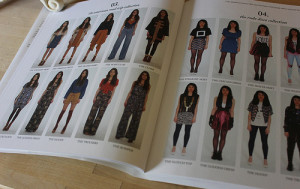
Now, I have to admit that I didn’t necessarily love most of the finished garments that were photographed for the book, but that was quite irrelevant to me. I don’t buy a house based on the color of the paint on the walls. I could tell right away that it was the infrastructure of the book that I wanted — tell me how to create these ten garments the way that I want to, and we’re all set. Based on my experience so far, I believe the author was successful in doing that. There are no tissue patterns included in this book — instead, the author walks you through the process of making your own pattern, which you can either draft on the paper of your choice or directly onto your intended fashion fabric. She uses a combination of personal measurements/preferences and existing garment tracing in order to create the pieces. I was excited about the prospect of learning this process, as I have extremely limited experience with it.
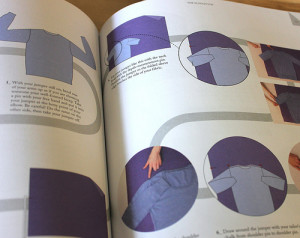
I automatically zoned in on the Grecian Dress as my first piece to attempt from the book. I think this was for two reasons: it looked extremely simple to make, and it was a style I could see myself wearing. The author drafts the garment directly onto her fashion fabric, but I wanted to create a paper pattern. I rarely — OK, never — make a garment the first time without subsequently wanting to make a few changes, and I knew this would be easier if I had a pattern from which to work. I drafted my Grecian Dress for a knit fabric, though I’d make very few changes to make it from a woven. I was really surprised at how easy it was to create my own pattern for this simple garment. By far, it took me less time than when I have to make an alteration to a commercial pattern. An even more importantly, I felt I knew the shape intimately — after I made the first version (nightgown, not pictured), I knew exactly where to go in the pattern to make the changes that I wanted to make. This may sound overly simplistic for such an uncomplicated garment, but I have had a lot of trouble over the years training my mind to think in the 3D realm that apparel sewing requires. So this was just the right experience to help me gain that confidence!
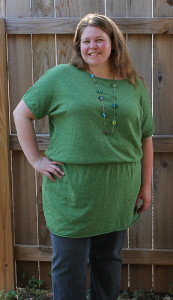
Normally when I review something for my blog, I detail precisely where I made modifications to the author’s pattern or techniques. Here, I’m not going to do exactly that because the instructions are really guideline-oriented anyway, meant to customize to your heart’s content. But here’s the scoop on my specific garment, in case you’re interested in making something similar:
- I made my garment long tunic length, using a measurement of about 40″ from the very top of the raw edge at the neckline, all the way to the bottom (as cut/unhemmed).
- I used 1/4″ elastic on the inside for the garment shaping at the waist. I attached the elastic 3″ below the waistline to result in the amount of blousing I wanted.
- I finished my edges with binding made from my fashion fabric, but left the raw edges exposed. I’ve been wanting to try this technique for a while. Basically, I just cut 1″ strips on the crossgrain, pressed them in half lengthwise, enclosed the garment’s raw edges in the folded strips, and stitched. I like the finished unfinished look. 🙂 It would be cute in a contrasting fabric too.
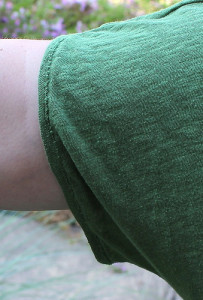
- I used a very lightweight slub cotton jersey from Fabric.com. I bought it about a year ago and it doesn’t look like this exact color is currently available, but here are the similar ones they have in stock. It was super stretchy which made the neckline a bit of a challenge, but it’s comfortable!
The other pieces that are high priorities in my to-try list are the cloak, the hoodie, and the romper. Thanks to Rosie Martin for an inspirational and educational book that will keep me busy for quite a while!
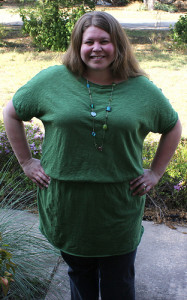
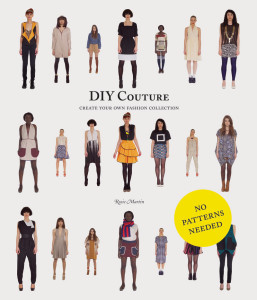

I have that book on amazon but I didn;t buy it when a reviewer posted there are no clothes for anyone over 30 or with an office job. But looking at the photos you posted, it appears length might be the only alteration needed…thanks for the review.
I am very happy you posted that review, because I felt exactlylike you with the book.
The pictures of the finished garments can be a bit off-putting, because it wouldn’t look like anything I would wear. BUT like you said, it is the process that makes the book interesting. The step by step instructions and the basic shapes are really quite useful to me.
On the first look it appears that no one over 30 would like any of the clothes and an experienced sewist would not need any of the details the author explains, but for me the making-it-up-as-I-go-along beginner it has some nifty details such as how to make a collar (either with sharp corners or Peter Pan style) and how to insert it, something that I had been looking at for a while.
I really, really like your tunic and what you did to alter it! (I want to make one now!) I noticed this book recently and wasn’t too thrilled by it. I am going to give it a second look and think about what it has to offer.
Sounds like a great patternmaking book that isn’t stuck in the early ninties like mine!
Thanks for using the instructions in my book it’s really great to see your finished grecian dress, you look very happy in it! It’s a beautiful colour. It’s a shame to hear people are put off the book as they think the clothing looks too youthful. I know many older ladies, including my Mum (!) who enjoy wearing cloaks and pleated skirts they created using my original DIY Couture instructions. I’m really happy that you didn’t let this put you off though, and I hope other people will do the same. I made the book as I wanted it to be used, so I hope all sorts of people can enjoy making clothes they love with the instructions. Rosie Martin x
Thanks, all! Yes, it does seem that the styling in the book has turned away some of the over-thirty crowd, but don’t let it deter you. The instructions are terrific and will enable you to make your garments however you like them. Rosie, thanks so much for your response and for the wonderful book!